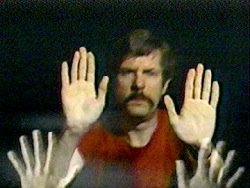Douglas Davis
Biography
As an artist, theorist, critic, teacher, and writer, Douglas Davis played an active role in contemporary art since the 1960s. A pioneer of video in the 1970s, his "live" satellite performance/video pieces were seminal exercises in the use of interactive technology as a medium for art and communications. In addition to his career as an artist, Davis was also an influential writer, authoring several books and serving as the art and architecture critic for Newsweek magazine from 1969 to 1988.
In 1977 Davis joined with Nam June Paik and Joseph Beuys for the first live international satellite telecast by artists, transmitted from Documenta 6 in Kassel, Germany.
Davis' pioneering work with interactivity evolved with new technologies. His participatory project for the World Wide Web, entitled The World's First Collaborative Sentence (1994), was commissioned by the Lehman College/CUNY Art Gallery for the exhibition InterActions. The project grew in scope and content for six years, eventually including text from 200,000 individuals. After technological obsolescence rendered the project incompatible with Internet browsers, the Whitney Museum of American Art in New York modified the coding in order to continue the endeavor indefinitely.
As an artist/performer, Davis confronted the anonymity and passivity of television production and reception, establishing an intimate, interactive dialogue with the viewer as a forum for intellectual and moral debate. Articulating his approach to video, Davis writes: "Television is usually considered a public medium, but because of the way it is experienced — in a personal space — it is in fact quite private. When I began to work overtly with the medium, I acted out of the same sense of intimacy, this time on the other side of the screen."
Davis was the author of several books, including Artculture: Essays on the Post-Modern (1977) and The Museum Impossible: Architecture and Culture in the Post-Pompidou Era (1990), and The Five Myths of Television Power: Or, Why the Medium Is Not the Message (1993). He worked as a freelance editor and writer before becoming an art critic for the National Observer. After moving to New York City, Davis became the architecture and art critic for Newsweek magazine, a position he held from 1969 to 1988.
Davis was born in 1933 in Washington, D.C. and died in 2014. He received a B.A. from American University and an M.A. from Rutgers University. He was the recipient of numerous awards, including fellowships from the National Endowment for the Arts, the Rockefeller Foundation, and the Deutscher Akademischer Austauschdienst (D.A.A.D.); he was also an artist-in-residence at the TV Lab at WNET/Thirteen, New York.
Davis' work has been seen in solo shows at the Centre Georges Pompidou, Paris; Metropolitan Museum, New York; Everson Museum of Art, Syracuse; and The Kitchen, New York, among other institutions. His work has also been exhibited at festivals and institutions including the Venice Biennale; Neue Galerie, Graz, Austria; Centro de Arte y Communicacion, Harrod's en Arte, Buenos Aires; The New Museum, New York; Wadsworth Atheneum, Hartford, Connecticut; Center for Art and Media, Karlsruhe, Germany; The Museum of Modern Art, New York; Hirshhorn Museum and Sculpture Garden, Washington, D.C.; Whitney Museum of American Art, New York; Kolnischer Kunstverein, Cologne; and the Solomon R. Guggenheim Museum, New York. Davis lived in New York until his death in 2014.
